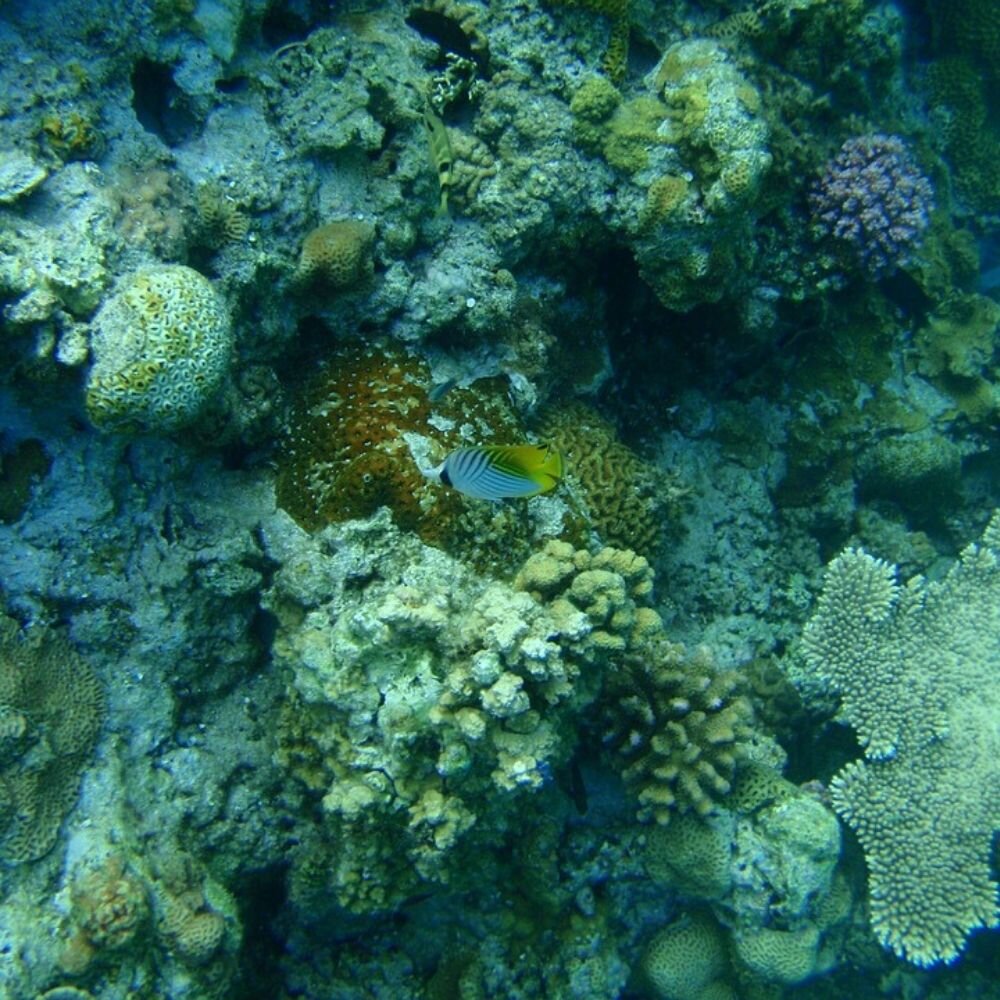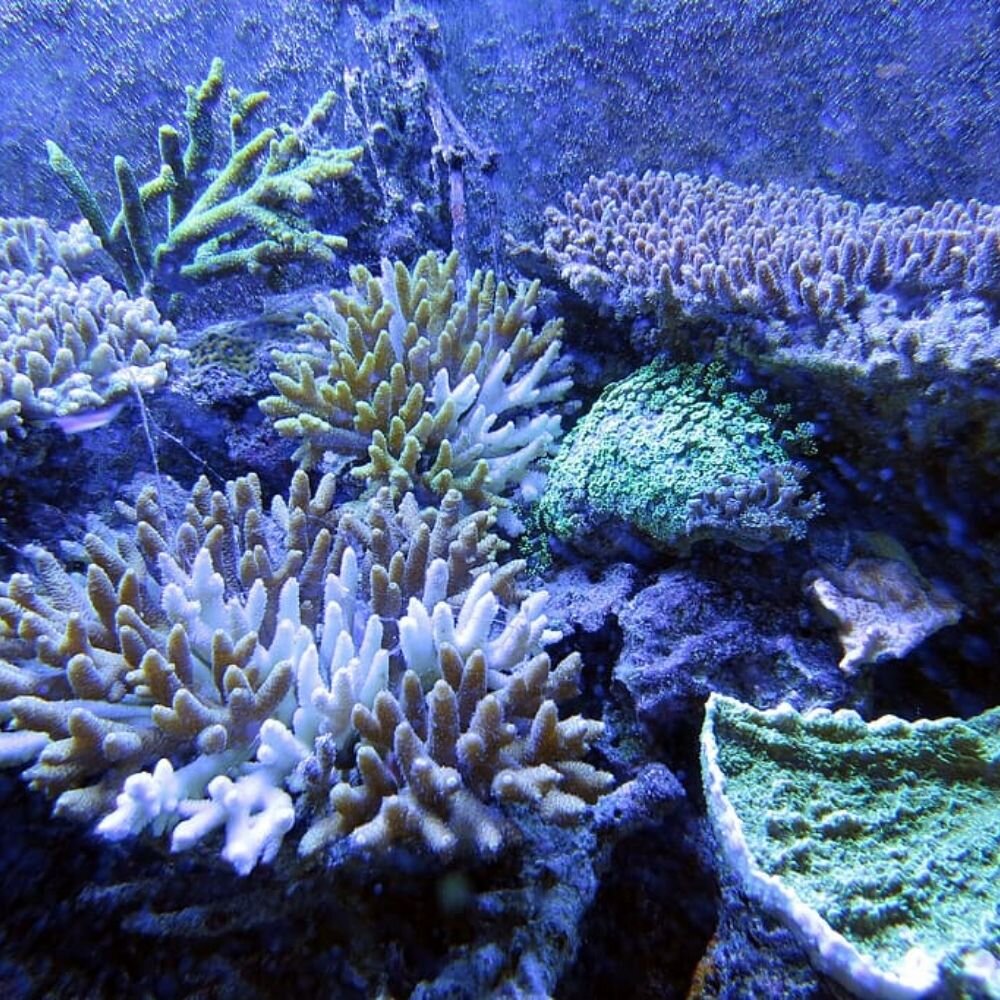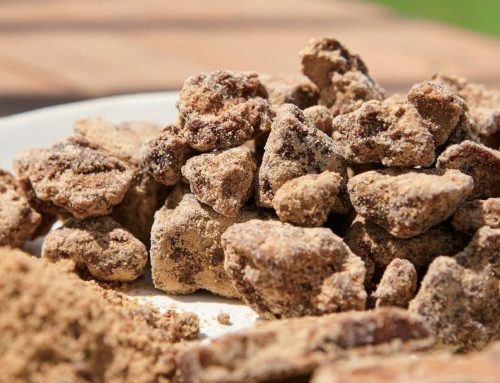Far from the living reef of Okinawa, in deep, dark seawater where coral cannot grow nor live, the seabed is made of fossilized coral grains. Environmentally friendly collection methods are used to harvest this fossilized coral.
Coral growth
Over 800 species of coral have been confirmed in the world and 400 species in Japan. Amongst all, Okinawa is world famous for its wide variety of coral and their purity.
Although, coral is commonly mistaken for a plant due to the shape of its branches and leaves, it is a marine invertebrate animal that grows from eggs. The surface of a coral reef is covered with numerous polyps, zooxanthellae, which are home to larvae algae. Coral and zooxanthellae support each other’s survival. Zooxanthellae provide the coral with nutrition and oxygen produced during photosynthesis. They are responsible for coral’s bright colours. In return, they receive nutrition in the form of nitrogen and carbon dioxide emitted by the coral.
In recent years, the rising temperature of seawater has placed stress on the coral leading to zooxanthellae escaping from the polyps, the corals fading, and the resultant bleached appearance of the coral. Should the temperature remain high, coral will die without the zooxanthellae. Maintaining the water temperature creates the proper environment for the transport of coral eggs and larvae, growth distribution and the healthy structure of coral.
Nature sustaining itself
Coral mineralises the irrigation water used in farming, allowing for chemical-free agriculture practices. As coral nutrients mineralise the earth, good microorganisms in the soil proliferate to help the crops grow strong. Healthy soil contains a variety of life around tree roots. Rainwater is filtered through the heavy covering of leaf mold to become clean groundwater, clean rivers, and clean farmlands, leading to a greater diversity of organisms.
Coral powder
Coral can live for hundreds to thousands of years, at the end of which, the dried weathered reef coral can be used to derive coral powder. When the coral dies, its skeleton remains on the seafloor as weathered, porous, natural mineral material. Over thousands of years, the skeleton is finely crushed by natural waves and tidal currents. Weathered fossilised coral grain accumulate as coral sand on the deep seafloor.
Weathered reef coral is dried, sterilized and powdered into a tasteless, odourless, yellowish-brown powder. By consuming naturally grown coral powder made from weathered reef coral that has died, we rely less on artificial materials. It is found that human absorption of minerals is improved when you ingest the nutrients contained in whole living beings rather than as separate minerals.
Coral minerals
Okinawa’s coral reefs biomineralize by harnessing the energy of the sun and sea, storing the rich minerals in their skeleton. By ingesting the natural ingredients of the clean seawater, the minerals of sea coral are better balanced than that of mountain coral. Over 70 types of minerals have been identified in coral.
Calcium carbonate is the main component making up 34%-85% of coral powder, with the remaining components being magnesium carbonate and other marine minerals.
23 of the major minerals residing in coral are: Ca (calcium), Mg (magnesium), Na (sodium), K (potassium), P (phosphorus), Fe (iron), Cl (chlorine), S (sulfur), Si (silicon), Al (aluminum), Sr (strontium), Cr (chromium), Co (cobalt), Ni (nickel), Mn (manganese), Cu (copper), Zn (zinc), Mo (molybdenum), V (vanadium), Li (lithium), F (fluorine), I (iodine), B (boron)
Coral calcium benefits
Coral calcium is naturally porous; full of microscopic holes. Even the smallest grains of powdered calcium coral are a few microns in size, retaining this porous quality. As it is less dense than calcium carbonate from limestone, you absorb it more easily into your bloodstream. Coral calcium is also easier for the stomach to handle. Because of the porous nature of coral calcium, one gram has a greater surface area than other types of calcium carbonate. If we consume one gram of coral calcium, we are exposed to a larger volume; which translates to a higher absorption rate by the body’s cells.
Environmental safety in coral calcium harvesting
There are many threats to the survival of coral. Seas around the world are polluted, for example, by large ships, nuclear testing, marine dumping, oil spills, or sewerage.
However, the waters around Okinawa carry a low risk of pollution leading to a high safety standard of their coral.
Rigid guidelines are adhered to in harvesting coral grains while protecting the living reef ecosystem. The integrity of the seawater is preserved in several ways.
-
Ocean depth
Coral grows best in shallow waters, where sunlight touches the seafloor. In Okinawa, coral lives in depths of up to 30 metres. For the manufacture of coral powder, only coral grains in depths greater than 60 metres – where no living coral grows – are collected.
-
Distance from the shore
Okinawa coral reefs reach out to 500 metres from the shore, where depths are still uniform at around 30 metres. Beyond this distance, the seafloor descends acutely to a depth of 50 metres. While coral collection is allowed beyond 500 metres, environmentally conscious coral harvesting occurs oftentimes beyond 1000 metres from the shore.
-
Stirring of coral grains
Pumps lain on the seafloor send soft vibrations that stir the coral deposits; which release some nutrients into the sea to feed the marine life and living coral.
Coral calcium manufacture
-
Inspection
Weathered reef corals that are collected are inspected for impurities or contamination.
-
Rough processing
Coral grains are processed into raw material for water purification agents.
-
Grinding and refinement
The roughly processed raw material is crushed into micron size and processed into powder for food and cosmetics.
-
Product packaging and inspection
The processed products undergo further quality inspection before being approved for use.
Functions of coral powder
-
Water purifier
Natural coral grains work to remove impurities from water, such as residual chlorine. Their alkalinity helps to neutralise water acidity.
-
Health supplement
Coral grains in subtropical Okinawan sea are rich in essential minerals, such as calcium, magnesium, zinc, copper, manganese, iodine and selenium, all in their natural ratio; which is ideal for the human body. Hence, coral powder is recommended for supplementing minerals that modern day consumers tend to lack.
-
Cosmetics









